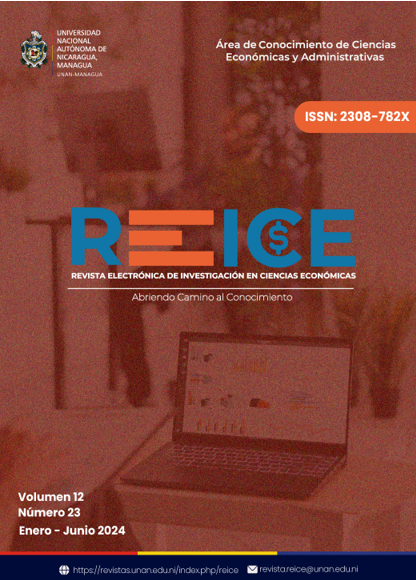Producción Agrícola Sostenible y Seguridad Alimentaria en Nicaragua
DOI:
https://doi.org/10.5377/reice.v12i23.18276Palabras clave:
Seguridad alimentaria nutricional, diversificación de cultivos, cambio climático, estrategias de adaptaciónResumen
En este artículo científico se aborda algunos factores que impactan la producción agrícola a pequeña escala en las zonas productoras de Nicaragua y, su relación en la seguridad alimentaria nutricional, destacando la importancia de enfoques integrales y sostenibles, donde se examina el impacto del acceso limitado a recursos, tales como disponibilidad de fuentes de agua, acceso a créditos y adopción de herramientas tecnológicas agrícolas , a los que suelen enfrentarse los pequeños productores agrícolas en diversas partes del país. Y de como la diversificación de cultivos se convierte en una herramienta fundamental para mejorar la disponibilidad de alimentos en el territorio. Además, La investigación también considera la influencia del cambio climático en la producción agrícola y propone estrategias de adaptación.
Descargas
486
Citas
Altieri, M. A. (1985). Agroecología: base scientíficas para una agricultura alternativa. Chile: CETAL.
Bageneta, J. M. (2015). Obtenido de file:///C:/Users/Usuario/Downloads/Dialnet-CooperativasAgrariasUnaHistoriaRegionalRelacionesD-7302465.pdf
Bendaña, G. (2022). Opciones de Diversificación con Potencial Desarrollo en el Agro de Nicaragua. Managua: Managua.
Bernal, M. (2017). Diversificación Agrícola: alternativa para productores. Obtenido de https://elproductor.com/wp-content/uploads/2017/03/REVISTA-MARZO.pdf
Castillo, O. (2008). Paradigmas y Conceptos de Desarrollo Rural. Bogotá, Colombia: Pontificia Universidad Javeriana.
CCAD. (2010). Estrategia Regional de Cambio Climático.
CEPAL. (2018). Acompañamiento Técnico y Fortalecimiento de Capacidades de lso Productores Agropecuarios en el Contexto de Cambio Climático en Costa RIca. México.
CIAT. (2018-2020).
CIRIEC. (2014). Obtenido de https://www.redalyc.org/pdf/174/17433883006.pdf
Cultivos Tropicales. (2016). Obtenido de https://www.redalyc.org/pdf/1932/193246554018.pdf
FAO. (2013). Obtenido de https://www.fao.org/3/i3247s/i3247s.pdf
FAO. (2014). Obtenido de https://www.fao.org/3/i3788s/i3788s.pdf
FAO. (2014). Aquastat.
FAO. (2014-2015). Obtenido de https://www.fao.org/3/i5754s/i5754s.pdf
FAO. (2020). Obtenido de https://www.fao.org/3/cb1447es/cb1447es.pdf
FAO. (2020). Obtenido de https://www.fao.org/3/cb1447es/cb1447es.pdf
FAO. (2022). Obtenido de https://www.fao.org/3/cc2459es/cc2459es.pdf
FAO. (2022). Obtenido de https://www.fao.org/3/cb8350es/cb8350es.pdf
Garcia, Y. (2015). Obtenido de file:///C:/Users/Usuario/Downloads/Dialnet-CalidadDelAguaConFinesDeRiego-5362999.pdf
GWP. (2011). Situación de los Recursos Hídricos en centroamérica. Obtenido de https://www.gwp.org/globalassets/global/gwp-cam_files/situacion-de-los-recursos-hidricos_fin.pdf
IICA. (2014). Obtenido de https://repositorio.iica.int/bitstream/handle/11324/3070/BVE17069004e.pdf?sequence=1&isAllowed=y
IICA. (2022). Obtenido de https://repositorio.iica.int/bitstream/handle/11324/20744/BVE22088367.pdf?sequence=1&isAllowed=y
Interciencia. (2007). Obtenido de https://www.redalyc.org/pdf/339/33932810.pdf
IPCC. (2007). Fourth Assesment Report (AR4). Intergovermental Panel on Climate Change.
J. Rojas & J. Ramirez. (2011). Desarrollo Rural en Nicaragua. Managua: Aldea. Obtenido de https://repositorio.unan.edu.ni/1824/1/284.pdf
JICA. (2015). Guía Técnica para Cosechar el Agua de Lluvia. Obtenido de https://www.jica.go.jp/Resource/project/ecuador/001/materials/ku57pq000011cym2-att/water_harvest_sp.pdf
JICA. (s.f.). Manual de Conservación de Suelos y Aguas. Obtenido de https://www.jica.go.jp/Resource/project/spanish/panama/2515031E0/data/pdf/1-11.pdf
López, M. (2013). Obtenido de file:///C:/Users/Usuario/Documents/Articulo%20Cient%C3%ADfico%202023/art%C3%ADculo%20Mario%20L%C3%B3pez.pdf
López, M. (2013). Obtenido de file:///C:/Users/Usuario/Documents/Articulo%20Cient%C3%ADfico%202023/art%C3%ADculo%20Mario%20L%C3%B3pez.pdf
López, M. (2013). Obtenido de file:///C:/Users/Usuario/Documents/Articulo%20Cient%C3%ADfico%202023/art%C3%ADculo%20Mario%20L%C3%B3pez.pdf
MAGFOR. (2009). Plan sectorial roRural Incluyente 2010-2014. BONO, E. 2008. Cambio climático y sustentabilidad económica y social: implicaciones sobre el bienestar social. CIRIEC (Esp.) Disponible en URL: https://www.redalyc.org/pdf/174/17412302004.pdf.
Méndez Álvarez. (2006). Metodología: diseño y desarrollo del proceso de Investigación con énfasis en ciencias empresariales. México: Limusa Noriega Editores.
Navarro, C. G. (2017). Obtenido de file:///C:/Users/Usuario/Documents/Articulo%20Cient%C3%ADfico%202023/Acceso%20al%20cr%C3%A9dito.pdf
PNUD. (2014). Informe sobre Desarrollo Humano.
Rodríguez, E. (2016). La problemática del agua en Nicaragua. Obtenido de file:///C:/Users/Usuario/Documents/Articulo%20Cient%C3%ADfico%202023/Eleonora.pdf
Rojas, J. (2019). Obtenido de file:///C:/Users/Usuario/Downloads/Dialnet-VinculoEstadoSectorTecnologicoProductivoYSuContrib-7304358.pdf
Rojas, J. (2019). Obtenido de file:///C:/Users/Usuario/Downloads/Dialnet-VinculoEstadoSectorTecnologicoProductivoYSuContrib-7304358.pdf
Sonino A. & Ruane J. (2003). Obtenido de ttps://www.fao.org/3/ar635s/ar635s.pdf
UNESCO. (2007). Organización de las NAciones Unidas para la Educación, la Ciencia y la Cultura.
Descargas
Publicado
Cómo citar
Número
Sección
Licencia

Esta obra está bajo una licencia internacional Creative Commons Atribución-NoComercial-CompartirIgual 4.0.
Copyright (c) Revista Electronica de Investigacion en Ciencias Economicas
Los derechos sobre los artículos publicados en REICE son de la revista, a los efectos de poder gestionar su mejor difusión. No obstante, puesto que la finalidad de la misma es la difusión del conocimiento, esta revista provee acceso libre inmediato a su contenido, bajo el principio de que hacer disponible gratuitamente la investigación al público, lo cual fomenta un mayor intercambio de conocimiento global.
Las opiniones expresadas por los autores no necesariamente reflejan la postura de la editora de la publicación ni de la UNAN-Managua Se autoriza su reproducción y distribución (en cualquier tipo de soporte) siempre que se cumpla las siguientes indicaciones:
- La autoría del trabajo
- Que se indique su origen (revista REICE, volumen, número y dirección electrónica del documento)

